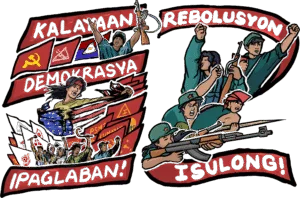Update of the economic and political situation in Eastern Visayas
To advance forward, it is important to take advantage of the present conditions to effectively gain strength and debilitate the enemy. The Philippine ruling system today is in crisis as never before in its history. This is inextricably bound up with the present crisis of the world capitalist system. It is expected that will this even worsen in the coming years. Every time the crisis in the country and the world sinks even deeper, it results in worse suffering, exploitation and oppression of the people. The people's demand for radical change becomes even more widespread and forceful. We must grasp the favorable situation in the country and the world in a way that is firmly related to the concrete conditions of the people in the region where we are situated
In the past decade, the Eastern Visayas economy has become even more backward and imbalanced corresponding to the semifeudal Philippine economy. This is because of the avowed adherence of the Arroyo regime to the policy of globalization that favors the imperialists, comprador big bourgeoisie-landlords and big bureaucrat-capitalists, led by the Arroyo family and its minions.
The increasing majority of the agricultural land in the region is devoted to commercial crops that are exported out of the region and the country. Meanwhile, only a fourth of the agricultural land in the region is devoted to rice and other basic food crops for the people's consumption. The inherently backward system of tilling in the region is even worsening: the percentage of irrigated rice lands declined from 35% to 17%; the farm lands are divided into ever smaller parcels; and the use of agricultural machine or even farm animals remains negligible.
Thus, the regional agriculture is all the more unable to fulfill the growing demands of the increasing population of Eastern Visayas, which is now around 4.2 million. While the reactionary government claims that rice production in the region is enough, the amount of rice imported in the region grew ninefold in the past decade (from 250,000 sacks in 1995 to over 2,000,000 sacks in 2008). Meanwhile, the Arroyo regime uses the pretext of extending assistance through irrigation, fertilizer and seeds in releasing billions of pesos that are principally intended for looting by the Arroyo family and its principal political cohorts in the region.
As in other parts of the Philippines, the real direction of the Arroyo regime's agricultural program in Eastern Visayas is to spread the planting of commercial and export produce such as coconuts, abaca, tuba-tuba and corn (for animal feeds). This not only increases the danger to food security as well as increases the dependence of the region on importing food, aside from other products. The entire agricultural sector plummets even further as well in the face of the world economic crisis. As what happened from 1980-1990, the 1.7 million people in the 400,000 hectares of coconut land or 60% of the agricultural land in the region are burdened once more with the further depreciation of the already low copra price because of the decline in the worldwide demand for coconut oil.
There still is no substantial industrial activity in the region. Even though the number of enterprises in the region increased from 10,000 in 1980 to over 20,000 today, only 17% of these are really dedicated to manufacturing, and 98% of these establishments employ not more than ten each. The number of big establishments (employing more than 200) in the region worthy of being called real industrial enterprises can be counted on the fingers of the hand. And the two major ones of these, Philphos and PASAR, which produce semi-manufactured products accounting for 91% of regional exports, were obliged in the past years to drastically reduce production because of the decline in orders from abroad.
It is highly laughable for the Arroyo regime and its leading political minions in the region to boast of economic progress here. They point to the growing numbers of stores including some malls, the setting up of a few call centers, improvement in communication and transportation facilities, the alleged tourism boom and even the increased population in some cities and town centers. But all these only affirm the real character of our backward economy: being simply a dumping ground of finished products and the cache of agricultural and natural riches for looting by the imperialist powers.
Such activities in the service sector that comprises 36% of the regional economy have no lasting and significant contributions toward improving production capacity and the self-reliance of the national and regional economy. The insubstantial and limited employment that these create does not uplift the rising rate of unemployment (4.2% as of April 2008) and underemployment as well as the high rate of out-migration, one of the highest if not the highest in the Philippines.
Because of the backwardness and imbalance of the economy, Eastern Visayas remains one of the poorest regions in the Philippines. Of more than three million peasants, two million are farm workers, poor and lower middle peasants who earn on average less than P50/day because of landlessness or scant land of their own. They suffer various levels of exploitation through land rent and usury, low pay for farm work, the high costs of renting farm animals and farming implements, expensive agricultural inputs (seeds, fertilizer, and pesticides), low costs of their products, and the high costs of basic commodities as well as in fraudulent deals. These dire conditions remain the same despite 20 years of the Comprehensive Agrarian Reform Program (CARP) of the reactionary government.
Such conditions are almost the same when it comes to the fisherfolk, workers, semi-workers, urban poor and even ordinary employees. The minimum daily wage (non-agriculture) in the region is pegged at P238, which is not even received by the majority of the employed, while a family needs P450 daily to live decently.
Meanwhile, the quality and reach of social services in the region continues to decline because of the reactionary government's neglect, prioritization of military expenses and foreign debt payments, and the looting of public funds by officials from the national to the local level.
Of the more than 700,000 households in the region, half do not have electricity; 80% do not have potable water; half live in houses that they do not own and that are of low quality; less than one percent have adequate toilet facilities; and more than 99% make do with wood, charcoal or petroleum as fuel. There are just over 50 public hospitals in the region and there is only one hospital bed for every 1,500 people and one doctor for every 10,000 people. Eastern Visayas has one of the highest rates of illiteracy in the country because of the lack of public schoolteachers, schools and classrooms.
Along with the worsening economic situation, the people of the region also suffer from the increasingly savage repression especially under the Oplan Bantay Laya campaign of the regime and the AFP. Aside from human rights violations, this enemy campaign resulted in massive dislocation and economic destruction to the already shaky livelihood of the people, especially in the countryside.
The 8th Infantry Division of the AFP is the principal machinery relied upon by the reactionary state and the Arroyo regime in the region. Eastern Visayas today is one of the focuses of the regime and the AFP's OBL. This intends to spread terror in the region, by the more aggressive suppression of the people's expression of their grievances and the cooptation of the civil political authority, the media and the church to subordinate them under the authority and interests of the military and the regime. But after the initial shock of the OBL, the mass movement step by step gained the momentum to advance their rights and livelihood. Even those temporarily silenced among the ranks of local government officials were in the main unable to be forced by the military to actively participate in the counterrevolutionary and anti-people campaign of the 8th ID. The continuing intensification of the NPA's tactical offensives against the overextended and vulnerable military in region also gives great inspiration and fortitude to the people and the political entities in the region, in standing up and rendering the 8th ID inutile politically and militarily.
Next and the close confreres of the military are the pro-Arroyo reactionary politicians who swagger in the region today especially at the level of some provinces. They actively support the various corruption rackets of the Arroyo regime as well as the oppressive campaign to suppress the people and the revolutionary movement here. In exchange for their support, they are apportioned hundreds of millions as their share of the loot, as well as given the leeway for their own local rackets that siphon off public funds and in fortifying and widening their political fiefdoms. They naturally are among those who strive that the Arroyo regime remains in power indefinitely. There is great need to expose, oppose and bring to account these politicians for their anti-people, counterrevolutionary and rotten deeds as an important aspect in fighting the Arroyo regime.
According to the inherent character of reactionary politics in the Philippines today, these pro-Arroyo reactionary politicians squabble among themselves while each ambitiously covet more loot and power. There are not a few cases where they attempt to change the political divisions in the region through such instances as pushing for new provinces, separating the city from the province, and raising the classification of a town to a city. The reactionary politicians are driven to compete against each other to prove their worth to the Arroyo regime and receive its patronage. Yet they also seek out the democratic mass movement as well as the revolutionary movement out of their desperation to garner mass support for their selfish interests that they mask as for the progress of the people and the region. While striving to expose these rotten dealings of reactionary politics, these must also be taken advantage of by the democratic mass movement and the revolutionary movement to advance the interests of the people, gain advantages for the movement, win over the broadest support and set the sights of the broad united front against the principal target, the Arroyo regime.
There is no other political force in the region aside from the revolutionary movement led by the Party that offers the real alternative solution to the economic and political crisis of the Filipino people today, and which seriously challenges the existing reactionary ruling system. It continues to spread and take root in various parts of the region and all sectors of the people here. Its influence in overall regional politics cannot be shrugged off. Every new intensification of armed struggle and the mass struggles all give inspiration to the broad masses of the people in the region to stand up and advance towards change.
The economic and political circumstances in the region are extremely favorable for waging revolution today more than in the past. The rottenness of the ruling system is very much exposed. The people strongly desire revolutionary change. But there can be no change without struggle. And a struggle that is spontaneous and impetuous will not succeed. The enemy classes are aware, organized and oppressive in defending their state power.
The line and program of the Party are clear in advancing the people's democratic revolution. But these are useless without enough material force in advancing these. Thus it is the basic obligation of the entire Party and all revolutionary forces to take advantage of the highly favorable situation today and at any time. The masses of the people in their hundreds of thousands and in their millions must be earnestly, tirelessly and systematically aroused, organized, won over and mobilized for the revolution.

